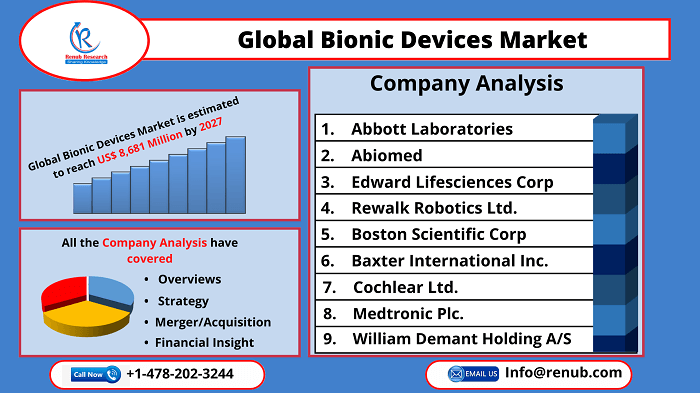Global Bionic Devices Market will Grow and Reach US$ 8.68 Billion by 2027, Due to Increasing Prevalence of Heart Disease Worldwide
20 Jan, 2023
According to Renub Research latest report “Global Bionic Devices Market, Size, forecast 2022-2027, Industry Trends, Share, Growth, Company Analysis” Global Bionic Devices Market is estimated to grow at a CAGR of 9.9%, and reach US$ 8,681 Million by 2027. Bionic devices are implants that are used in place of the natural function of the body part that is lost due to nerve damage. An electronic or mechatronic part is used to replace or supplement the functionality of the damaged body part.

According to the data published by the World Health Organization in October 2021, about 2.2 billion people were affected with blindness or vision impairment, out of which at least 1 billion people had unaddressed or preventable conditions globally. Presently, the bionic eye is being developed by various companies worldwide to supply a usable device with the purpose of helping sight impaired individuals.
According to the World Health Organization statistics, published in 2021, road accidents roughly accounted for 1.3 million deaths globally. Around 20 to 50 million people suffer attributing to non-lethal injuries during road accidents, with many among them leading to a disability and to traumatic amputation. This increase in number of road accidents and high patient preference for bionic implants is expected to add to the growth of the market.
Furthermore, the growing number of chronic conditions, increasing prevalence of hearing loss, huge population of individuals with heart disease worldwide, emergence of new medical facilities, growth in expenses related to healthcare, are some of the major contributors to the growth of global bionic devices market.
Cochlear Implants device segment is expected to dominate the market share:
The rise in hearing loss is the major contributor to the dominance of the segments market, cochlear Implants device has maximum market share. The individuals who suffer from hearing loss can benefit from assistive devices including cochlear implants, hearing aids, and others. The introduction of minimally invasive procedures, technological improvements, and favourable funding and reimbursements.
Wearable/extremely worn device market is expected to grow at a lucrative rate:
The factors such as, customer preference towards the technologically advanced products, and the acceptance of wearables in various application areas, has contributed to the growth of the wearable/extremely worn device segment in the bionic device market.
Mechanical bionic devices market is expected to register a significant growth in the market:
In this technology driven era, the need and requirement for technologically advanced and improved products had increased immensely. The bionic market is also driven by this factor. So, based on technology, the electronic bionic devices market has dominance in market share. This is because, most of the developing countries, still use prosthetics, such as artificial hands, arms, and legs, for the disabled people.
However, the mechanical bionic devices market is forecasted to have a higher growth rate in the future. The favourable reimbursement policies, rise in FDA approvals, and to the longevity it provides in comparison to other devices, are some other factors that propel the growth of the market.
Hospital segment has the highest market share, based on end-user:
The presence of skilled healthcare professionals, availability of better facilities, and presence of better and updated medical equipment’s, are the key contributors to the high market share of the hospital segment, in the global bionic device market.
Asia-Pacific market is forecasted to register a high growth rate during the forecast period:
The increasing prevalence of disabilities, increasing demand for bionic implants, and rise in trauma and accidents, propels the growth of the embolic devices in the region.
However, North America has a dominant market share. This is due to high prevalence of chronic diseases, rising healthcare expenditure, and acceptance of bionic devices by the population of the region.
Competitive Landscape:
Some of the key players of the global embolic device market are; Abbott Laboratories, Abiomed, Edward Lifesciences Corp., Rewalk Robotics Ltd, Boston Scientific Corp, Baxter International Inc., Cochlear Ltd, Medtronic Plc, and William Demant Holdings A/S.
Market Summary:
- Treatment - The Report covers Global Embolic Device Market, by treatment in 4 viewpoints (Cochlear Implants, Exoskeletons, Bionic Cardiology, and Ventricular Assist Device).
- Fixation - By fixation, Renub Research divides the Global Embolic DeviceMarket into 2 viewpoints (Implantable, and wearable/ extremely worn).
- Technology - The Report by Renub Research segments by technology into 2 viewpoints (electronics, and mechanical devices).
- End-User - Global Embolic Device Market breakup by end-user in 3 viewpoints (hospitals, clinics, and others segment).
- Region - Renub Research report covers by region in 5 viewpoints (North America, Europe, Asia-Pacific, Latin America, and Middle-East and Africa).
- Key Players - All the major players have been covered from 4 Viewpoints (Overview, Strategy, Merger/Acquisition, and Financial Insight) Abbott Laboratories, Abiomed, Edward Lifesciences Corp., Rewalk Robotics Ltd, Boston Scientific Corp, Baxter International Inc., Cochlear Ltd, Medtronic Plc, and William Demant Holdings A/S.
Reach out to us
Call us on
USA: +1-678-302-0700
INDIA: +91-120-421-9822
Drop us an email at
info@renub.com